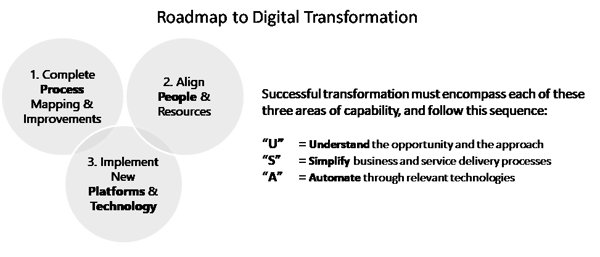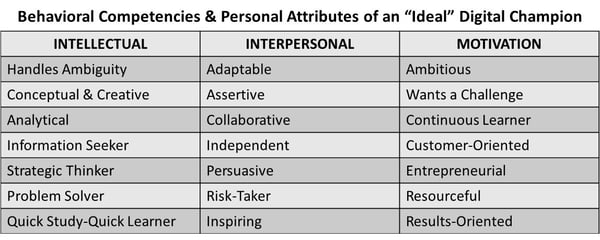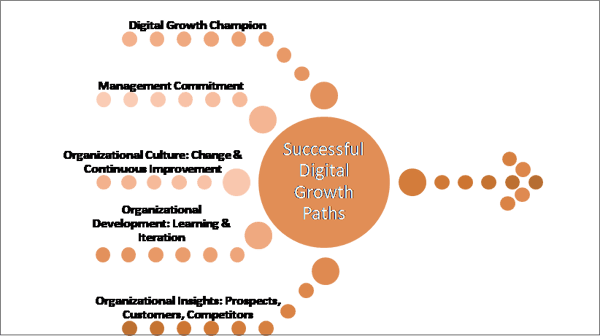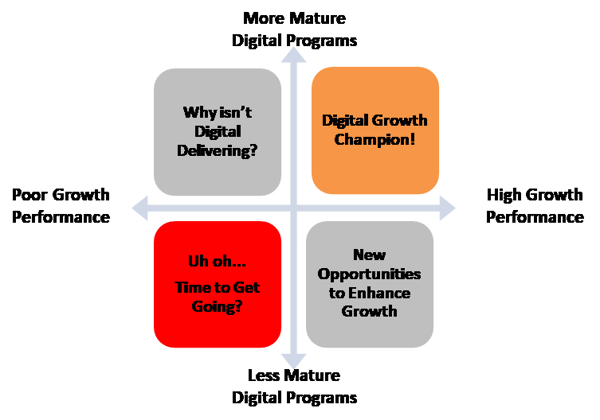CEO Blog - Advice for CEOs on growth and scaling
The Role of People and Organizational Structure in Digital Growth for Small- and Mid-Sized Businesses (SMBs)

 This is the third in a series of articles focused on helping executives in small- and mid-sized businesses utilize digital technologies effectively to assist in accelerating revenues and profits. If you missed the first two articles, you can find the first one here and the second one here.
This is the third in a series of articles focused on helping executives in small- and mid-sized businesses utilize digital technologies effectively to assist in accelerating revenues and profits. If you missed the first two articles, you can find the first one here and the second one here.
The previous articles included an introduction to four major ways digital technologies can help your business, described a spectrum of technologies and a possible implementation roadmap, and associated digital proficiency with enhanced business performance. The second article also took a deep look at how business process needs and priorities should help guide your digital paths. In that article, I also introduced the “USA” model for digital transformation.
We are ready discuss the second step on the “USA” digital roadmap: “Align People and Resources.”

Challenges Aligning People and the Organization
Successful digital transformation requires all of these key organizational characteristics and resources:
A Digital Growth Champion
A digital growth champion can come from your business or IT organization and has a strong passion for servicing customers in new ways, a good understanding of digital technologies, and also a good understanding of how your business operates.
More than anything, this champion has a unique combination of behavioral competencies and personal attributes:

Management Commitment to Digital Transformation
I've been in situations where the CEO or one other executive was the sponsor for digital initiatives, and while that can work, it is much healthier when the full management team gets on board. At one company where I led the digital initiatives, Phil, the vice chairman, was the sponsor, and while I had his unflagging personal support and access to financial resources, it did not guarantee me access to the business and IT support resources I needed. Saying "Phil wants this project" only works so many times.
I’ve also authored digital transformation strategies for large healthcare organizations. Even with key influential medical staff on-board, other parts of the organization thought digital was more of a threat to their roles than an opportunity to serve patients better and improve patient care.Securing a broad management commitment takes work and can be time-consuming. But, getting this upfront is very critical to securing the resources the organization will need to implement digital initiatives.
Organizational Culture with a Passion for Change and Continuous Improvement
Some businesses think that what they have done historically will also serve them in the future. I’m all for bringing culture, values, assets and competencies with you on your digital path. Those organizations which realize that change is inevitable, and which choose to get ahead of their competitors, will thrive. Digital drives growth, and growth is required for healthy revenue and profit streams. Growth-oriented businesses outperform their peers. Check these resources out here and here if you want to learn more.
Continuous improvement includes a willingness to try new things and an understanding of risk and rewards. It also recognizes that few digital initiatives start and launch without some modification of requirements, features, and even market positioning.
Organizational Development Built on Learning and Iteration
Here’s an example of both learning and iteration. An early version of a web-to-print business I launched started with a software program which you needed to install on your PC. Just like AOL…remember when you got your free AOL disks at the check-out line?
This business was very innovative, and offered many benefits over traditional short-run, color printing. On launch, industry analysts kept asking us what type of software they should categorize this under. It wasn’t really a fit with any existing category. Finally, we recognized that we needed to drop the “product” description and refer to this as a “service.” We re-positioned this as a service within 45 days after launch. If we had stayed with the “product” positioning, I don’t think the launch would have been nearly as successful.
The lesson here: you are unlikely to end up exactly where you think you will go before you launch, but that’s OK. It’s much better to plan to be 65% correct with your initial release and have the internal iterative processes and funding reserve to fine-tune once you are actually in the market.
Organizational Insights into what Prospects and Customers Want (Voice-of-Customer)
What functionality and benefits do your prospects and customers want? What makes a great digital experience from their point of view? What would they suggest that you work on first? What are your competitors up to? Don’t know?
Rather than guess what value your digital initiatives can offer, and what order this list should follow, wouldn’t it be confidence-building to ask them? After joining a major bank and reviewing the last two years of customer satisfaction surveys, I found that customers consistently rated our on-boarding processes as worst-in-class. We realized that these processes would benefit from digital support, redesigned them, digitally-enabled them, launched them, and turned our customer ratings to best-in-class in the next survey. In fact, we actually branded our onboarding services and included performance guarantees.
The benefits didn’t stop there, either. Since the faster and more efficiently we onboarded customers the faster we would see transaction revenue, we improved not only customer satisfaction, but also our own revenue streams and timing. These are the kinds on “win/win” scenarios we are looking for in our digital growth plans.
It's unlikely that in your relevant market, yours is the only business thinking and acting digitally. It’s a best practice to do deep dives on your competitors and their digital initiatives. Today, it’s pretty easy to make simple comparisons like the performance of your website against others’. It’s also pretty easy to understand what they are doing for online sales, customer experiences, and other value-added digital growth initiatives.
What is hard to discern, but still important, is being able to describe their digital strategies and plans. You’ll want to understand not only what you can see of your competitors, but what their plans are to stay in the race. This information is more of a challenge to discern, but also more important to know since your plan must consider delivering equal or better capabilities for you to remain competitive.
People and Organizational Building Blocks
There are several ways of illustrating the building blocks described in this article. Here’s a simple model to reinforce the points I’ve made.

Can We Finally Talk About Digital Technologies?
Not quite yet—we’ll get there when we look at Platforms in the next article in this series. We are following the USA approach as we lay out a digital transformation roadmap.
Where to From Here?
Next up in our series of best practices to implement effective digital engines of growth in your business are these two follow-on articles:
Topic: Platforms:
This article will examine building a robust set of enabling tools which fit into the business, adopting and standardizing scorecards, financial models, business cases and business plans, and completing periodic reviews of voice-of-customer VOC, competitive monitoring, and market analyses.
Topic: Roadmap, Results, Metrics, Benefits
This installment will emphasize effective adoption of best practices, offer a logical sequence to implementation, and discuss building organizational and program maturity. These articles will help you understand how to achieve “digital growth champion” status!
Please stay tuned for more practical guidance as we bring best practices for implementing engines of growth in your business.

An Opportunity to Engage!
Do you have ideas to share? Are there topics you would like me to specifically address? Shoot me an email and I’ll be happy to chat with you.
Topics: Digital Marketing Tactics, Business Growth Strategy, Digital Marketing, Marketing Technology, SMB
Thu, Jun 21, 2018Related Articles

- Press Releases
- Careers
- Case Studies
- Marketing Consultant Company
- Marketing Strategy Consultants
- Marketing Plan Consultants
- B2B Marketing Consultants
- Virtual CMO
- Marketing Consultant Outsourcing
- Fractional CMO
- What is a Fractional CMO
- Healthcare Marketing Consultant
- Marketing Consultant Houston TX Texas
- Marketing Consultant Texas TX
- Marketing Consultant Bay Area
- CEO Blog
- Ebooks Plus
- Executive Marketing Consultants
- Product Marketing Consultants
- B2C Marketing Consultants
- Virtual Marketing Consultants
- Senior Marketing Consultants
- Temporary CMO
- Hire a CMO
- Fractional CMO Salary
- Fractional CMO Responsibilities
- Marketing Consultant Austin TX Texas
- Marketing Consultant Dallas TX Texas
- Marketing Consultant San Antonio
- Helping Private Equity
- Private Equity Blog
- Leadership Team
- Privacy Policy
- Business Marketing Consultants
- Strategic Marketing Consultants
- Marketing Technology Consultants
- Sales and Marketing Consultants
- CMO Job Description
- CMO Salary
- Fractional CMO Agency
- Fractional CMO Services
- CPG Marketing Consultant
- Marketing Consultant San Diego
- Partners
Houston, TX 77056
© 2023 Chief Outsiders


